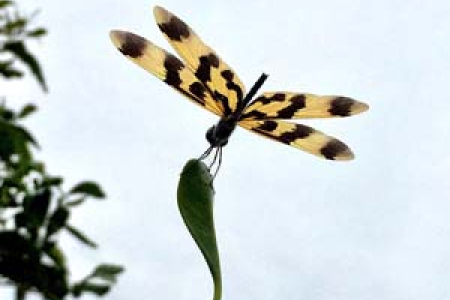Dragonflies search for hot date with mate
A flurry of activity is expected in Top End skies with dragonflies set to start searching for a mate as they take flight in the lead up to the dry season.
With a change in season just around the corner, Charles Darwin University aquatic ecologist and dragonfly expert Professor Jenny Davis is compiling information for a guide to the Northern Territory’s dragonfly and damselflies.
“There are dragonflies around throughout the year, but not in the great numbers we see towards the end of the wet season and the beginning of the dry season,” Professor Davis said.
In compiling a field guide on the dragonflies of the Top End she also will look to fill gaps in knowledge regarding the natural history of the insects.
“We think that the influx of numbers is most probably due to their life cycle,” she said. “Dragonflies and damselflies spend most of their lives as juveniles (larvae) in water where they feed, however, the phase most people see them in is the adult stage.”
She said the winged adult stage allowed the dragonflies to move great distances, with one species called the “Global Wanderer”, which is found in the Top End, travelling the globe to find a mate.
“We see them swarming at the beginning of the dry season, they have entered their adult stage and have one thing on their mind,” she said. “They want to find a mate.” Although their appearance is considered to be a welcome sign that the wet season is coming to an end, ultimately, for a dragonfly, it is all about sex.
She said Australia was home to more than 300 species of dragonflies, with the tropics providing the ideal conditions for many.
“The NT boasts an amazing diversity of spectacular species, such as the brightly coloured Scarlet Percher, which is often found perching on reeds near water, and the distinctive Graphic Flutterer which, as the name suggests, can be seen fluttering around in small flocks, often near the coast,” she said.
Professor Davis said that many dragonfly species could be identified by their size and colour, but there was considerable variation within a species, both between males and females, and with age.
“Often the males are more spectacular than the females in order to attract a mate,” she said. “Mating often involves a complex set of behaviours, much of it undertaken while in flight.”
With 65 species added to the guide so far, mostly from earlier work in Kakadu National Park, she said she hoped to finalise the field guide by the end of the year.
Professor Davis is head of the School of Environment at CDU. Her broader research focuses on the impacts of stressors such as urbanisation and climate change on crucial aquatic ecosystems such as wetlands and shallow lakes.
